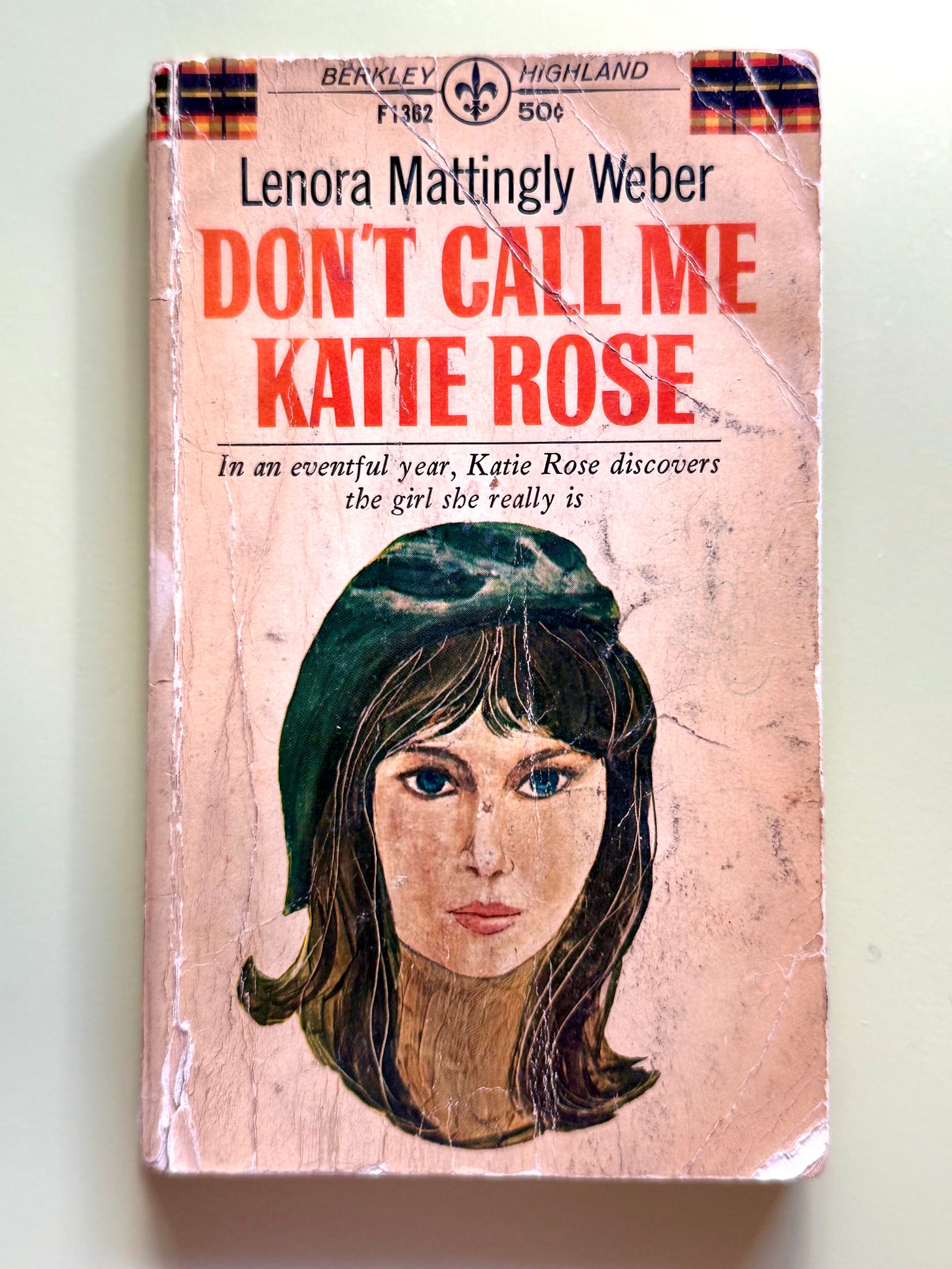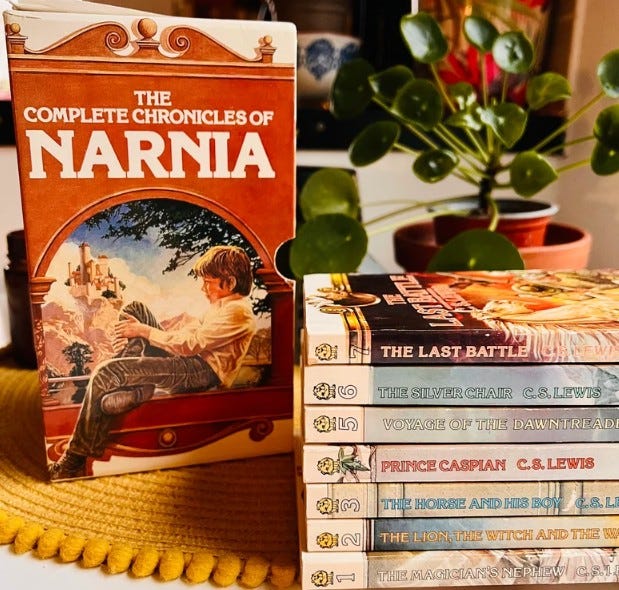Fairy tales
and a recipe for an unexpectedly wondrous cream of celery soup
To everyone new here, welcome. I’m Elizabeth, the writer of The Delicious Bits Dispatch, a weekly missive for the curious, blending discovery, reflection, and musings, always wrapped up with a seasonal recipe worth lingering over.
“…some day you will be old enough to start reading fairy tales again.”
C.S. Lewis, dedication to Lucy Barlow, The Lion, The Witch and the Wardrobe
Every reader has an origin tale; mine is stitched from a patchwork quilt of strange bedfellows.
Both the youngest and only bookworm in my family, I was that stereotypical kid with the flashlight under the covers. My early hunger for books was indiscriminate. Along with the inane and palatable Scholastic books we could order every year, I somehow managed to read Gone with the Wind in grade 5 (missing most of the complex themes and history recasting but being dazzled by Scarlett’s green velvet curtain dress); I stumbled onto Daphne du Maurier, and I read Don’t Call Me Katie Rose over and over again, to dog-eared tatters.

What I didn’t quite get around to in those early years were the fairy tales. There may have been books under the Christmas tree, although if there were, it was a rare occurrence. A new doll, a cylinder of Tinkertoys, tangerines tucked in the toes of our Christmas stocking—treats as magical as something from Aladdin’s cave—those were the treasures I remember most vividly.

Then, in grade four, Miss Byrne read The Lion, the Witch and the Wardrobe aloud to the class, and I was captivated: talking fauns, a magic wardrobe, The White Witch with her enchanted Turkish Delight, and of course, Aslan.
That moment opened a door into a world of the fantastical, the surreal, the magical—and to things that didn’t exist in my world but might, if only I opened the right door. I didn’t have to wait for the annual viewing of The Wizard of Oz on television; whole realms were already waiting for me inside the covers of a book.
Even so, it would be another eighteen years before I discovered the full world of Narnia and the magic within it.
“When I became a man I put away childish things, including the fear of childishness and the desire to be very grown up.”
—C.S. Lewis, On Three Ways of Writing for Children

I don’t know how I first stumbled onto the fact that The Lion, the Witch and the Wardrobe was only one part of a larger whole—and not, as I had long thought, the sum total of the Narnian adventures. It was the same kind of dawning I later felt with the Star Wars films: realizing the story wasn’t being told in order, that the narrative itself was out of sequence, leaving the audience suspended in a state of discovery.
As a child, Narnia was pure enchantment and fantasy. But when I discovered the whole series eighteen years later, I found something else waiting — truths about sacrifice, courage, and redemption that may not have pierced my tender child’s heart.
J. R. R. Tolkien, he of Lord of the Rings fame, saw the same power in fairy tales. He called this recovery—that moment when fairy stories allow us to see ordinary things with fresh eyes, “to look at green again, and be startled anew by blue and yellow and red.”
Read this way, fairy tales and myths are not diversions from adult life but tools for navigating it.
“Myth is the truth of the imagination. The stories may not have happened, but they are always happening.”
—Madeleine L’Engle, Walking on Water: Reflections on Faith and Art
To set aside the tales of our childhood is to dull one of our sharpest tools of moral and imaginative vision. To return to them as adults is to discover what was there all along: the old stories are still alive—and they are still shaping us. Myths and fairy tales as living narratives, continually reshaped across time.
If you liked this post, let me know by clicking the ❤️ button. It helps spread the word about Delicious Bits and brings me joy. Thank you, dear readers and eaters!
Cream of Celery Soup
Six Seasons, Joshua McFadden
serves 4 to 6
Long before it found its way into lunchboxes, the veggies and dip tray or Bloody Caesars, celery was a plant of legend. The ancient Greeks crowned their athletes with it, yet also laid it on graves to honour the dead. Romans whispered about its powers of love and passion, while storytellers tucked it into charms and potions. In other words: this humble stalk has always carried a little magic.
Yet still, this often overlooked stalwart of the produce drawer often doesn’t get to play a starring role. That idea is turned on its head with this simple but sublime soup recipe from vegetable wizard Joshua McFadden.
Look for a firm head with plenty of flavourful leaves.
Ingredients
2 tablespoons unsalted butter
1 head celery, cut into 1-inch pieces, leafy tops chopped and reserved
1 small onion, diced
Kosher salt and freshly ground black pepper
4 cups vegetable stock or water
½ cup roughly chopped lightly toasted walnuts (see page 31)
¼ cup raisins, plumped in warm water for 15 minutes, drained
1 teaspoon celery seed
Extra-virgin olive oil
½ cup heavy cream
Put the butter, celery, and onion in a large pot over medium heat. Season lightly with salt and pepper and cook the vegetables slowly until they have begun to soften and release their juices, about 8 minutes. Don’t let the vegetables brown at all.
Add the stock, adjust the heat to a simmer, and cook until the celery and onion are completely tender, about 30 minutes. Let the soup cool a bit, then process in a blender to make a smooth purée. You may need to do this in batches.
Meanwhile, toss together the reserved chopped celery leaves, walnuts, raisins, and celery seed in a bowl and moisten with a few drops of olive oil.
Return the purée to the pot, add the cream, and bring everything to a low simmer. Cook for about 5 minutes to soften the cream flavor. Taste and adjust the salt and pepper. Divide into serving bowls and top with the walnut-raisin mixture.



Did you know that the name Narnia was inspired by the Umbrian city of Narni? We have a beautiful Narnia coloring book, and have watched the movies several times. It’s probably time I read the books with my daughter.
A lovely post once again Elizabeth.
I had to chuckle, while at university I also compared The Lion, the Witch & The Wardrobe to Star Wars in an essay! Around arguments for and against a chronological narrative.
There is definitely something about returning to fairytales as adults. I have often found them alarming. My poor daughter received a feminist critique when she tried to watch Disney's Cinderella. 😂